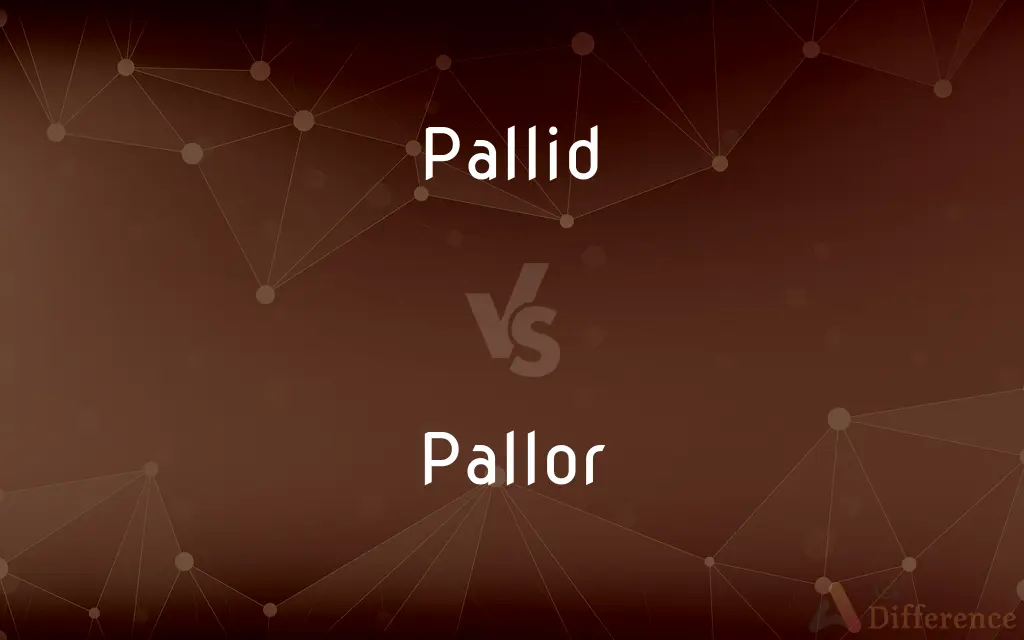Pallid vs. Pallor — What's the Difference?
By Urooj Arif & Maham Liaqat — Updated on April 26, 2024
"Pallid" describes a pale appearance or complexion, often due to illness or faintness, while "pallor" is the actual condition or state of having a pale or wan complexion.

Difference Between Pallid and Pallor
Table of Contents
ADVERTISEMENT
Key Differences
"Pallid" is an adjective used to describe someone or something that has an unusually light complexion, often suggesting poor health or lack of vitality. On the other hand, "pallor" is a noun that refers to the appearance or condition of being pale, typically from illness or distress.
"Pallid" can be used more broadly to describe any pale, dull, or lackluster quality, such as in description of an environment or an object. Whereas pallor specifically refers to the human complexion, indicating an absence of color which can be a symptom of a variety of medical conditions.
In literary contexts, "pallid" is often used metaphorically to convey a sense of lifelessness or ineffectiveness, such as a "pallid performance" or "pallid skies." In contrast, "pallor" is used more clinically or descriptively, focusing strictly on the physical symptom of paleness.
The use of "pallid" might also imply a temporary or superficial state, as in a fleeting facial expression or reaction. Conversely, "pallor" usually suggests a more sustained or noticeable condition that could be indicative of an underlying health issue.
While "pallid" conveys a qualitative aspect of paleness, "pallor" quantifies the extent or degree of paleness observed, often in medical or health-related discussions.
ADVERTISEMENT
Comparison Chart
Part of Speech
Adjective
Noun
Definition
Having a pale or deficient color
The condition of being pale, typically from illness or shock
Usage Context
Descriptive, often used metaphorically
Medical, descriptive
Example Usage
"His face turned pallid with fright."
"Her sudden pallor worried her friends."
Connotation
Can suggest weakness or lack of vitality
Indicates a possibly serious health condition
Compare with Definitions
Pallid
Not bright or lively.
The pallid version of the song lacked the energy of the original.
Pallor
Reflecting a general appearance or impression of paleness.
The pallor of the moonlight gave the night an eerie feeling.
Pallid
Dull or uninspiring.
The review criticized the movie's pallid dialogue.
Pallor
A lack of color or brightness.
The pallor of the landscape in winter can be striking.
Pallid
Pale in color or tone.
The pallid light of dawn crept through the curtains.
Pallor
Paleness of the skin, often as a result of illness or shock.
The doctor noted his pallor during the examination.
Pallid
Lacking color, especially in a way that suggests poor health.
The long winter left him with a pallid complexion.
Pallor
Used to describe a symptom in medical contexts.
Pallor is often a sign of anemia.
Pallid
Faint or weak.
She managed a pallid smile despite her nervousness.
Pallor
Associated with fear, stress, or emotional distress.
Her face showed a sudden pallor when she heard the news.
Pallid
Having an abnormally pale or wan complexion
The pallid face of the invalid.
Pallor
Pallor is a pale color of the skin that can be caused by illness, emotional shock or stress, stimulant use, or anemia, and is the result of a reduced amount of oxyhaemoglobin and may also be visible as pallor of the conjunctivae of the eyes on physical examination. Pallor is more evident on the face and palms.
Pallid
Lacking intensity of color or luminousness.
Pallor
Extreme or unnatural paleness.
Pallid
Lacking in radiance or vitality; dull
Pallid prose.
Pallor
Paleness; want of color; pallidity; wanness.
Pallor of the complexion
Pallid
Appearing weak, pale, or wan.
The patient left the hospital but was very pallid.
Pallor
Paleness; want of color; pallidity; as, pallor of the complexion.
Pallid
Deficient in color; pale; wan; as, a pallid countenance; pallid blue.
Pallor
Unnatural lack of color in the skin (as from bruising or sickness or emotional distress)
Pallid
Abnormally deficient in color as suggesting physical or emotional distress;
The pallid face of the invalid
Her wan face suddenly flushed
Pallid
(of light) lacking in intensity or brightness; dim or feeble;
The pale light of a half moon
A pale sun
The late afternoon light coming through the el tracks fell in pale oblongs on the street
A pallid sky
The pale (or wan) stars
The wan light of dawn
Pallid
Lacking in vitality or interest or effectiveness;
A pale rendition of the aria
Pale prose with the faint sweetness of lavender
A pallid performance
Common Curiosities
Is pallor always related to health issues?
While often health-related, pallor can also be due to natural complexion or emotional responses.
What causes pallor?
Pallor can be caused by various conditions including anemia, shock, or lack of sunlight.
How do you use pallid in a sentence?
"After hearing the news, her face became pallid."
What is the difference between pallor and merely being pale?
Pallor specifically refers to unnatural or illness-related paleness, whereas being pale can be a broader and less severe condition.
Is pallor a reliable indicator of illness?
Pallor can be an indicator of illness, but it should be assessed alongside other symptoms.
What does "pallid" mean in medical terms?
In medical terms, "pallid" describes a pale appearance, often suggesting illness.
Can pallid have a positive connotation?
Generally, pallid does not have a positive connotation as it often implies lack of health or vitality.
Can objects be described as pallid?
Yes, objects or scenes can be described as pallid when they lack vividness or color.
How is pallor assessed in a clinical setting?
In a clinical setting, pallor is assessed by observing the decrease in the usual coloration of a person's skin, particularly in sites like the face, inner mouth, and nails.
What synonyms can be used for pallid?
Synonyms for pallid include wan, ashen, or blanched.
How does one differentiate between pallor due to fear versus anemia?
Pallor due to fear is usually temporary and may accompany other signs of distress, whereas anemia-related pallor is more persistent and often accompanied by other symptoms like fatigue.
How can pallor affect perception in art or film?
In art or film, pallor can be used to convey themes of illness, distress, or a ghostly presence.
What are the implications of a pallid environment?
A pallid environment implies a setting that is dull, lacking in vibrancy or excitement.
Is pallor considered a diagnostic feature?
Yes, pallor can be a diagnostic feature in medical evaluations, particularly in identifying conditions like anemia or circulatory issues.
Can pallid refer to emotional states?
Yes, pallid can describe emotional states by suggesting a lack of energy or vitality.
Share Your Discovery

Previous Comparison
Dawn vs. Sunrise
Next Comparison
Archetypal vs. PrototypicalAuthor Spotlight
Written by
Urooj ArifUrooj is a skilled content writer at Ask Difference, known for her exceptional ability to simplify complex topics into engaging and informative content. With a passion for research and a flair for clear, concise writing, she consistently delivers articles that resonate with our diverse audience.
Co-written by
Maham Liaqat













































